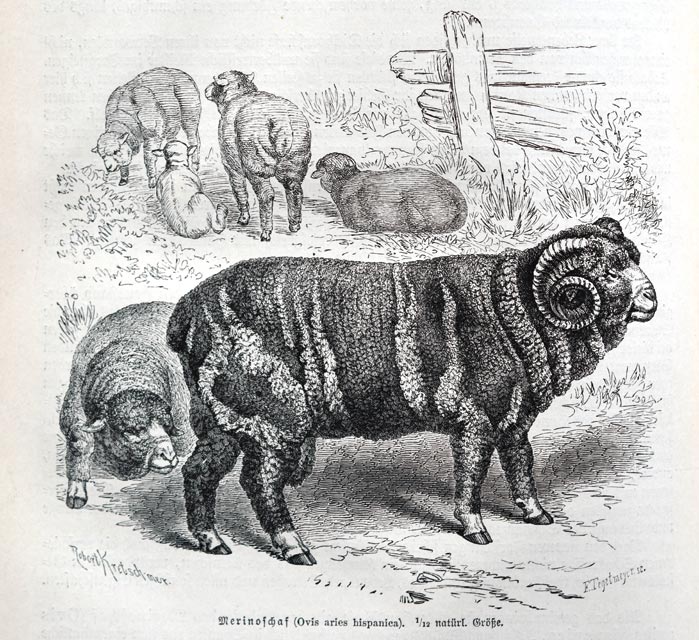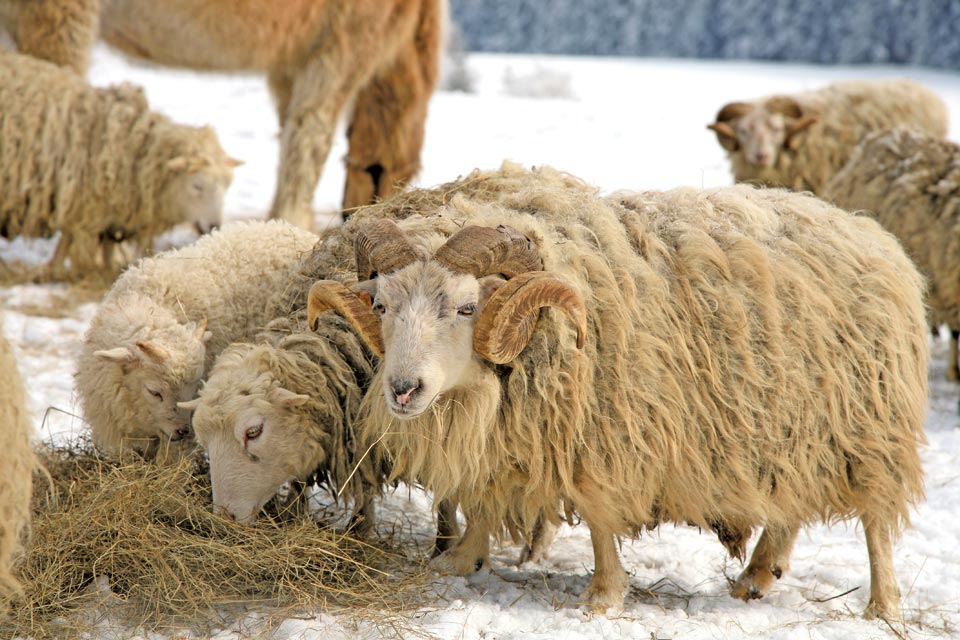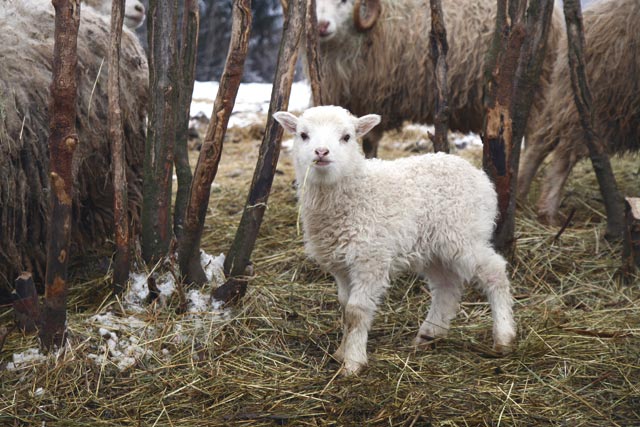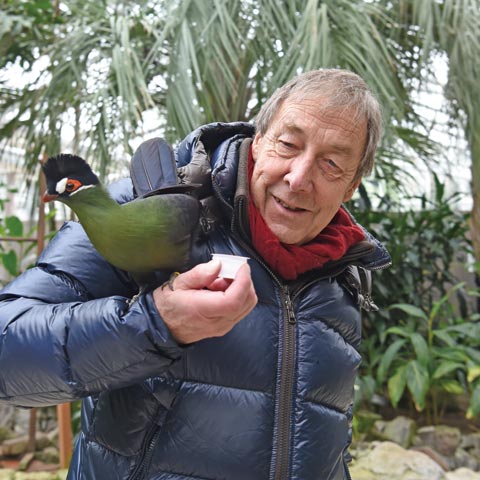野生のヒツジ、アルガリ(Ovis ammon)は約1万1千年前にユーフラテスとチグリス地域で家畜化された。イランとトルコではヒツジは家畜として9千年前から飼われており、その後8‐7千年前に南トルクメニスタンへ、7‐5千年前にインドへ、6千年前に東南アジアへ、そして4千年前に中国へと、人の手によって家畜のヒツジは分布を広げた。また約6千年前に中央ヨーロッパへ、4千年前にはイギリスとスカンジナビア半島にも持ち込まれた。野生のヒツジがアフリカに生息した記録はないが、家畜としてはリビアで7千年前から、エジプトでは6千年前から飼われている。

小型の野生のヒツジは食用として、また後に家畜化するにも好都合であった。ヒツジを家畜化するには、サイズをさらに小さくし、角を短くして、人になつかせる必要があった。現在でもさまざまな飼育条件に適応できるように、多種多様のヒツジが存在し高い可塑性を備えている。そのためにヒツジはさまざまな気候や生息環境の中で飼育され、新たな家畜改良目標も種の選択と異種交配によって容易に達成してきたのだ。5千年前に初めて家畜ヒツジの羊毛が利用されるようになり、ヒツジの価値が格段に上がった。2500年前には古代ギリシャとローマですでに良質のメリノ種のヒツジが飼われていた。一方で1870年に羊毛が値下がりした際、ドイツでは多くの羊農家が羊毛生産のための品種から食用に適した品種の飼育に転換している。

簡単にいえば昔も今も野生ヒツジの家畜化には、毛、皮、肉、乳の供給という4つの主要な目的がある。そして何世紀もの間に、さまざまな製品に特化した品種改良が行われた。現在では世界中に10億頭以上のヒツジが飼育されており、その多く(約4億頭)はアジアで飼われている。しかし高い生産性を持つ改良品種の影で原種の存在が忘れられ、その多くが絶滅または絶滅寸前まで追いやられてしまった。現在飼育されている古い種は、それを人類の文化として後世に残したいという専門家や愛好家らによって飼われるケースがほとんどである。

その中の1種が東プロイセンのスクドゥ(Skudde)で、最も小さく、最も古いドイツのヒツジである。スクドゥは北欧の、小型で細く尻尾が短い、いわゆるヒース羊だ。元々は東プロセインとバルト三国原産で、中世から第2次世界大戦時まではその地域でのみ飼育されていた。現在は家畜のレッドデータブックに掲載されており、小さな群れが少し残るだけで、その全てを合わせても1000頭程である。そして、そのほとんどがドイツ国内の動物園や個人の飼育によるものに過ぎない。その全個体の祖先を遡るとわずか数頭に行きつき、その数頭も献身的な畜産家によって保護され育てられたのである。特にミュンヘン動物園とライプツィヒ動物園のスクドゥの群れには驚かされる。もちろんリスクのある近親交配であることは言うまでもなく、ライプツィヒ動物園の群れが、たった1頭のメスとその子どもの子孫であることはまぎれもない事実である。
スクドゥの一番の特徴はらせん状の立派な角だが、メスのほとんどには角がない。体は小さく細い。オスの体高は50-65 cmで体重は30-50 kg。メスの体高は45-60 cmで体重は25-40 kgである。

毛質はこの種の特徴でもある、上質なウール繊維で短い毛と長い毛で構成されている。色は白や茶、黒やグレーなど。白いスクドゥには頭に斑紋があることが多い。尻尾は短く毛は硬い。子羊はうなじと足に赤褐色の模様があるが、成獣になると消えてしまう。スクドゥは体が小さいため食用にはほとんど飼育されていないが、肉はおいしいとされる。またスクドゥの放牧には荒地が適している。食べ物の好みもなくイラクサやギシギシも食べるので景観の保全にも寄与している。季節に関係なく発情し、一年を通していつでも子どもを産むことが可能である。規定では2年間に3頭まで子を産むことができる。また早熟でペアリングも8ヶ月目から可能だ。この高い繁殖率が唯一、ドイツの小さなヒツジを1940年代末の絶滅危機から救ったと言っても過言ではないのである。
Almost extinct but saved by conservation – the Skudde, an old German sheep breed
The Wild sheep (Ovis ammon) was domesticated in the Euphrates-Tigris region about 11.000 years ago. Domestic sheep are known in Iran and Turkey since 9.000 years. Afterwards domestic sheep were distributed by men, to South Turkmenia 8.000-7.000 years ago, to India 7.000-5.000 years ago, to South East Asia 6.000 years ago and to China 4.000 years ago. About 6.000 years ago the sheep was brought also to Central Europe and 4.000 years ago to England and Scandinavia. Wild sheep never lived in Africa, but domestic sheep are known in Libya since 7.000 years and in Egypt since 6.000 years.
The rather small size of Wild sheep was the ideal game for meat and later the reason for its domestication. Topics for domestication of sheep were to gain smaller size, shorter horns and a tame character. Even until today domestic sheep still have a large variety and plasticity to adapt easily to different husbandry conditions. Therefore they can be kept in several climates and habitats and new domestication goals can be achieved by selection and crossbreeding rather easily. When the domestic sheep showed 5.000 years ago the first wool fleece, their value became much higher and already 2.500 years ago the antique Greek and Romans kept sheep with a very fine Merino wool. On the other hand, when in 1870 the wool price decreased, the German sheep holders changed the sheep type from a sheep for wool production to sheep breeds with high portion of meat.
To summarize, the domestication of Wild sheep had and has also today 4 major goals: To deliver wool & merino, skin, meat and milk. Over the centuries very specialized breeds for the different products were cultivated. Today more than one billion sheep are kept worldwide, most of them in Asia (378 million). But because of their higher productivity these specialized breeds dismissed the original breeds which became endangered or extinct. Most of these traditional breeds are kept today only by some specialists or sheep breed lovers who want to save for future generations these old breeds as a proof for mankind’s culture.
One of these old breeds is the East Prussian Skudde which is the smallest and one of the eldest German sheep breeds. The Skudde is a nordic, rather small and slender built, short-tailed heather sheep. Its original homeland was East Prussia and the Baltic States where it was kept since medieval times until World War II. Today the Skudde is registered in the Red Data Book for Livestock animals and only a very few small herds with altogether 1.000-2.000 sheep can be found today, most of them in some zoos and on private grounds in Germany. All these stocks can be traced back to a very few individuals which were saved and bred by a few committed breeders. Remarkable are the Skudde herds in the zoos in Munich Zoo and Leipzig. Of course inbreeding can be a danger today, for example the herd in the Leipzig Zoo goes back on only one ewe and her son!
The most noticeable feature of the Skudde buck is the imposing snail horn. The ewes are hornless or carry horn stumps. The animals are small and slender. Bucks have a wither height of 50-65 cm and weigh between 35 and 50 kg. Ewes are smaller, 25-40 kg body weight and 45-60 cm wither height.
The wool mixture, which is typical for this breed, consists of fine wool fibres, dispersed with short hairs and course cover hair. The fleece can be white, brown, black or grey. White Skuddes have often small pigment spots on the head. The tail is short with bristly hairs. Lambs have a rust-coloured marking in the nape of the neck and on the legs. But this colour disappears in adults.
Because of its small size the Skudde is mostly not kept for its meat, although the meat is a delicacy. But the Skudde is very well suited for pasturing more barren areas and to contribute so to conservation of landscape. As it has no food preferences, this sheep breed is undemanding and feed even on stinging nettles and sorrel.
Skuddes come into heat aseasonally and lambs are born at any time of the year. As a rule 3 lambings are possible in 2 years. The Skudde is sexually precocious and its first pairing is already possible with an age of 8 months. This high reproduction rate was at least the guarantee for the survival of this small German Sheep breed after its collapse in the end of the 1940ies.

ユルゲン・ランゲ
生物学博士。1942年1月30日、デッサウ生まれ。キール大学、ミ ュンスター大卒業。ドイツで170年の歴史を誇るベルリン動物園/水族館で前統括園長かつCEOを務めた。欧州を代表する生物学者であり動物園学者、海洋生物学者。全世界の動物園水族館の新設やリニューアルを手がける動物園水族館コンサルタントとして、田井基文をパートナーに活躍中。
Dr. Jurgen Lange
Born: January 30th, 1942 in Dessau. Studied at Kiel University and University of Mテシnster. Former CEO and cdirector of the Berlin Zoo/Aquarium, which has a history of 170 years. He is one of the leading biologist in Europe as well as a zoo science expert and marine biologist. He works together with Motofumi TAI as a zoo and aquarium consultant, helping to build and renew zoos and aquariums around the world.

